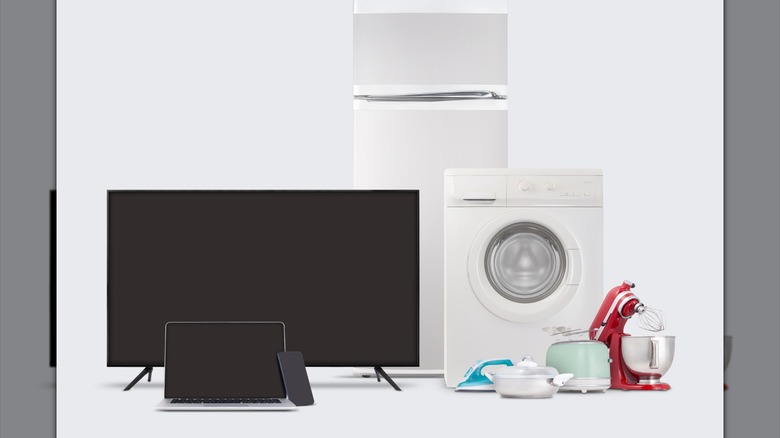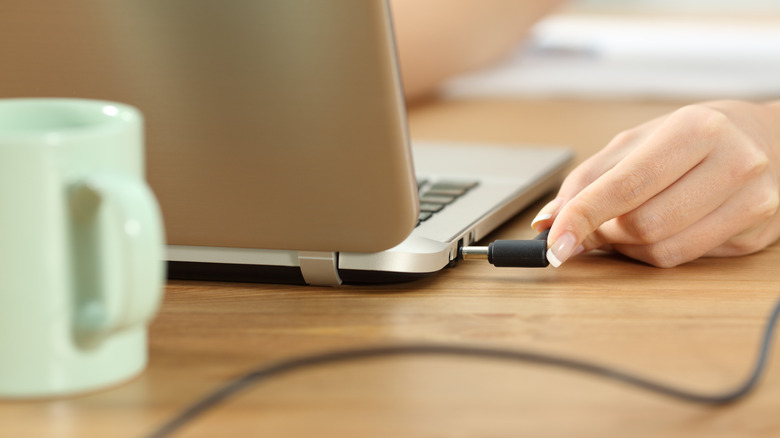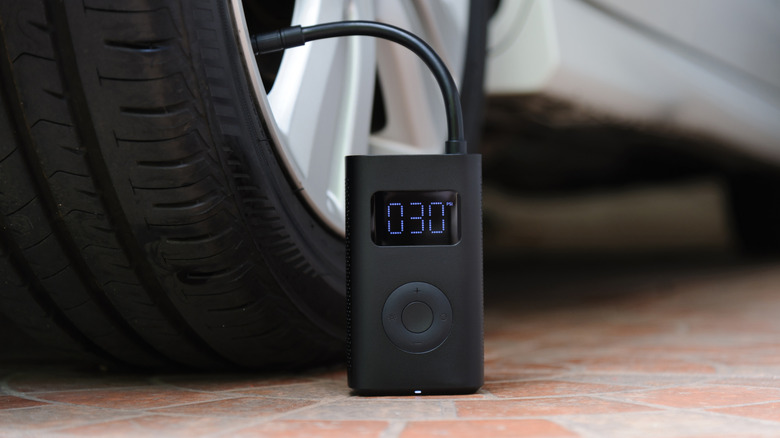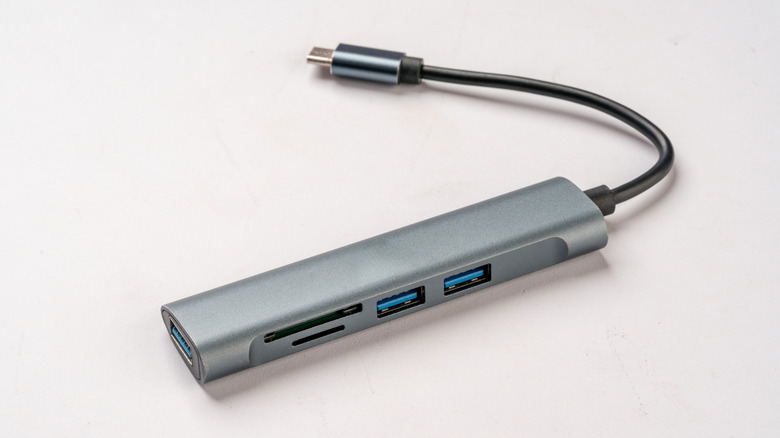Never Plug These 5 Things Into A Power Bank
Call it a boon or a bane, technological advancements have made us reliant on numerous electronic devices. Beyond portable gadgets, such as mobile phones, laptops, and tablets, we also use smart devices, including smart refrigerators, washing machines, ovens, lights, fans, and more. While most smart devices require a continuous power supply, portable ones, such as smartphones and laptops, come with a built-in battery. But that also means that their juice can run low. To avoid such situations, you can carry a portable power source with you — a power bank.
A power bank is a portable battery that lets you charge other devices on the go. With so many power bank manufacturers in the market, you'll want to choose a power bank from a trusted maker. But the selection process doesn't end there. You need to pick between a standard, wireless, or solar power bank.
Whichever you choose, you may still have questions whether you can charge a particular device with your power bank. To be clear, you shouldn't just plug any device into any power bank, as there are certain limitations and hazards to consider. In this guide, we have listed five things that you should never plug into a power bank.
Appliances that need AC mains
Power banks have different capacities that serve different purposes. Furthermore, they are designed in a way that they supply only DC (Direct Current) through their USB ports. However, the appliances that we use in our households use AC (Alternating Current) from a wall socket to function. This basic difference makes our household appliances incompatible with a power bank. Additionally, power banks are not designed to safely supply the amount of energy required by such heavy appliances to function without issue.
Even small appliances, such as toasters, draw between 800W and 1,800W of power. But unlike other appliances such as washing machines and refrigerators (not that you should plug these in either), which distribute energy intake over a period of time, toasters in particular use a lot of energy in a few minutes because they have to heat up quickly. This makes toasters incompatible, and you should never plug them into a power bank, as it could damage the internals of the portable power source and cause it to overheat and catch fire.
Similarly, coffee makers also fall in the range of 600W to 1500W, which a power bank could never provide (unless it is specified to do so). Overall, you should remember that portable power banks are meant to charge small devices and not full-sized home appliances. In simple words, if the appliance plugs into a wall, you shouldn't connect it to a power bank.
Laptops, gaming consoles, and monitors
Unless your power bank specifically says that it can handle high-powered devices like laptops, gaming consoles, and monitors, you should refrain from plugging them in. Most laptops' internal batteries may last up to eight hours on a full charge, except for some models that offer up to a day of battery life. You'll need some math (unless the box of the power bank specifies) in order to determine what capacity power bank can charge your laptop. Standard laptops typically demand somewhere up to 100W of power, while gaming laptops may consume far more wattage.
On the other hand, gaming consoles such as PlayStation, Xbox, or Nintendo Switch require a steady flow of current, often exceeding 150W, which exceeds the power that standard power banks can deliver. Thus, you shouldn't plug your gaming console into a power bank, because they aren't meant to power such high-power-consuming devices. The same is the case with external monitors or displays. They also need a constant and stable power supply to function properly, which standard power banks are simply not equipped to deliver.
Plugging these devices into a power bank is not only not recommended, but even if you got hold of a power bank that supports charging your console or laptop, it will run out of juice much sooner, as its capacity is limited compared to a wall source.
Power tools
Power tools like drills, saws, grinders, and electric screwdrivers connect to an AC source, as they require a continuous power supply. Power tools are also available in different types. Handheld power tools may consume anywhere between 500 to 1,000W of electricity, while large power tools such as table saws or miter saws may consume up to 3,000W of power. The electric consumption mainly depends on the power tools' motor power and torque. While the electrical consumption of power tools may vary, one thing remains the same, and that is, a typical power bank cannot handle such high-power delivery.
Standard power banks supply DC power, while most power tools are designed to function on an AC supply. Yes, you can purchase a large-capacity portable power station and power your heavy-duty tools, but don't expect a high supply from a standard power bank. Power tools are designed to run on dedicated power sources or have their own chargeable battery packs to provide the necessary current. Besides, it is essential that you have a separate circuit for power-hungry tools.
You will find cheap adapters or converters on Amazon that say to allow for such connections, but they are not recommended and are often unsafe. It is best to avoid using a power bank or any portable power source for power tools, especially mechanical and motor-driven tools.
12V car accessories
While cars are loaded with features, there are several gadgets that you can purchase to enhance the driving experience. Some essential car accessories include a portable tire inflator, vacuum cleaner, dash cam, mini fridge, etc. These gadgets are designed in a way that they will function with a 12V car socket, sometimes known as the cigarette lighter port. When connected, these accessories draw power from the car's battery, which can supply a higher and more stable current than a standard power bank.
Again, using an adapter or converter to deploy any of the 12V accessories could not only damage the device but also result in insufficient performance. Besides, the power bank could heat up, increasing the risk of a fire, which is not something you would want to happen with your car. Some devices, such as portable air compressors or coolers, can pull up significant power for a few moments, which goes past the safe power delivery rating of a power bank, unless specified.
If you really want to use your 12V car accessories, then you should invest in a portable power station that is rated for such high-electricity output. The best way would be to check if the accessory supports usage via a power bank. This way, you will have the appropriate capacity power bank to use with your car gadget.
Another power bank and USB hubs
Most people carry a portable power bank in case we need to charge our devices while on the go. But what if the power bank itself runs out of juice? If your friend is also carrying their own power bank, you might wonder if you can charge your power bank with it or not. Well, effectively yes. There are power banks that use a dedicated port for power delivery and a separate port for accepting power. So, while you can charge and use a power bank simultaneously, to charge one from another, you'll need to ensure that the functionality is present in both power banks.
However, if a power bank uses a single port for charging and power delivery, then it might get confused about whether it should send or receive power. So, you should check with the manufacturer if that particular model supports transferring power from one power bank to another. Unsupported power banks can fall into a power feedback loop, resulting in overheating, circuit damage, or even battery failure.
The same caution applies to USB hubs and splitters. While connecting multiple devices at once will get the juice flowing through all of your devices, a power bank's power delivery limit might get breached. This will lead to slow charging or no charging of all devices or damage the internal circuitry of the power bank.





